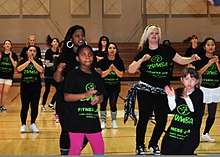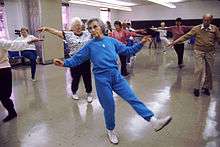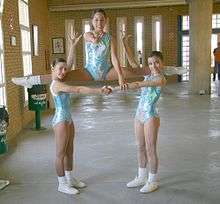Aerobics

Aerobics is a form of physical exercise that combines rhythmic aerobic exercise with stretching and strength training routines with the goal of improving all elements of fitness (flexibility, muscular strength, and cardio-vascular fitness). It is usually performed to music and may be practiced in a group setting led by an instructor (fitness professional), although it can be done solo and without musical accompaniment. With the goal of preventing illness and promoting physical fitness, practitioners perform various routines comprising a number of different dance-like exercises. Formal aerobics classes are divided into different levels of intensity and complexity. A well-balanced aerobics class will have five components: warm-up (5–10 minutes), cardio vascular conditioning (25–30 minutes), muscular strength and conditioning (10–15 minutes), cool-down (5–8 minutes) and stretching and flexibility (5–8 minutes). Aerobics classes may allow participants to select their level of participation according to their fitness level. Many gyms offer a variety of aerobic classes. Each class is designed for a certain level of experience and taught by a certified instructor with a specialty area related to their particular class.
History
Both the term and the specific exercise method were developed by Dr. Kenneth H. Cooper, an exercise physiologist, and Col. Pauline Potts, a physical therapist, both of the United States Air Force. Dr. Cooper, an avowed exercise enthusiast, was personally and professionally puzzled about why some people with excellent muscular strength were still prone to poor performance at tasks such as long-distance running, swimming, and bicycling. He began measuring systematic human performance using a bicycle ergometer, and began measuring sustained performance in terms of a person's ability to use oxygen. In 1968, he published Aerobics, which included exercise programs using running, walking, swimming and bicycling. The book came at a time when increasing weakness and inactivity in the general population was causing a perceived need for increased exercise. Cooper published a mass-market version "The New Aerobics" in 1979.[1][2]
Aerobics gained worldwide popularity after the release of Jane Fonda's exercise videos in 1982.
Step aerobics
Step aerobics is a form of aerobic exercise using of an elevated platform (the step). The height can be tailored to individual needs by inserting risers under the step. Step aerobics classes are offered at many gyms and fitness centers which have a group exercise program.
Step aerobics was developed by Gin Miller around 1989. After a knee injury, Gin consulted with an orthopedic doctor, who recommended she strengthen the muscles supporting the knee by stepping up and down on a milk crate and from this she developed the step regimen.

Step aerobics can also be involved in dancing games, such as Dance Dance Revolution or In the Groove.
Moves and techniques
Often moves are referred to as Reebok step moves in reference to one of the first makers of the plastic step commonly used in gyms.
The "basic" step involves stepping one foot first on the step then the other on top of the platform then stepping the first foot back on the floor with the second following. A "right basic" would involve stepping right foot up, then the left, then returning to the floor alternating right then left.
Many instructors of step will switch immediately between different moves, for example between a right basic and a left basic without any intervening moves, forcing people to "tap" their foot instead of shifting weight. However, one form of step is called tap-free or smooth step in which feet always alternate without the ambiguous "taps" that can make learning step difficult for beginners. This requires a bit of foresight and planning by the instructor in order to insert a transitional or switching move that maintains the natural alternating weight shift akin to walking. For example, from a series of right basics one may insert a "knee up" (which involves stepping up and lifting the knee and returning the lifted leg to the ground, thereby switching feet) and then continuing to a left basic. However, this requires planning and the extra beats required for the transitional move.

Common moves include:
- Basic Step
- Corner knee (or corner kick)
- Repeater knee (aka Triple knee)
- T-Step
- Over-the-Top
- Lunges
- V-Step
- Straddle Down
- L-Step
- Split Step
- I-Step
Choreography
Many instructors will prepare a set of moves that will be executed together to form the choreography of the class. Usually, the choreography will be timed to 32 beats in a set, ideally switching legs so that the set can be repeated in a mirrored fashion. A set may consist of many different moves and the different moves may have different durations. For example, a basic step as described above takes 4 beats (for the 4 steps the person takes). Similarly, the "knee up" move also takes 4 beats. Another common move, the repeater knee, is an 8-beat move.
Classes vary in the level of choreography. Basic level classes will tend to have a series of relatively basic moves strung together into a sequence. More advanced classes incorporate dance elements such as turns, mambos, and stomps. These elements are put together into 2–3 routines in each class. One learns the routines during the class and then all are performed at the end of the class. Regardless of the complexity of the choreography, most instructors offer various options for different levels of intensity/dance ability while teaching the routines.
Freestyle aerobics

Freestyle aerobics is an aerobics style in which a group instructor choreographs several short dance combinations and teaches them to the class. This is usually achieved by teaching the class 1-2 movements at a time and repeating the movements until the class is able to join the whole choreography together. Aerobic music is used throughout the class. This is sometimes followed by a strength section which uses body weight exercises to strengthen muscles and a stretch routine to cool down and improve flexibility. Classes are usually 30–60 minutes in length and may include the use of equipment such as a barbell, aerobic step, or small weights.
In freestyle aerobics, the instructor choreographs the routine and adjusts it to the needs and wants of her/his class. There is often no difference between base movements in freestyle and pre-choreographed programs.
It is practiced to improve aerobic fitness, flexibility and strength.
Aerobic gymnastics

Aerobic gymnastics, also known as sport aerobics and competitive aerobics, may combine complicated choreography, rhythmic and acrobatic gymnastics with elements of aerobics.[3] Performance is divided into categories by age, sex and groups (individual, mixed pairs and trios) and are judged on the following elements: dynamic and static strength, jumps and leaps, kicks, balance and flexibility. Ten exercises are mandatory: four consecutive high leg kicks, patterns. A maximum of ten elements from following families are allowed: push-ups, supports and balances, kicks and splits, jumps and leaps. Elements of tumbling such as handsprings, handstands, back flips, and aerial somersaults are prohibited. Scoring is by judging of artistic quality, creativity, execution, and difficulty of routines. Sport aerobics has state, national, and international competitions, but is not an olympic sport.
Benefits
Like other forms of exercise, step aerobics helps burn calories and fat. The number of calories burned depends on the speed of movements, step height, length of exercise, and the persons height and weight.
See also
| Wikimedia Commons has media related to Aerobic exercise. |
References
- ↑ ""Father of Aerobics" Kenneth Cooper, MD, MPH to receive Healthy Cup Award from Harvard School of Public Health". News. 2008-04-16. Retrieved 2018-10-08.
- ↑ "Dr. Kenneth Cooper and How He Became Known as the Father of Aerobics". Club Industry. 2008-09-01. Retrieved 2018-10-08.
- ↑ "About Aerobic". Fédération Internationale de Gymnastique. Retrieved 9 June 2014.